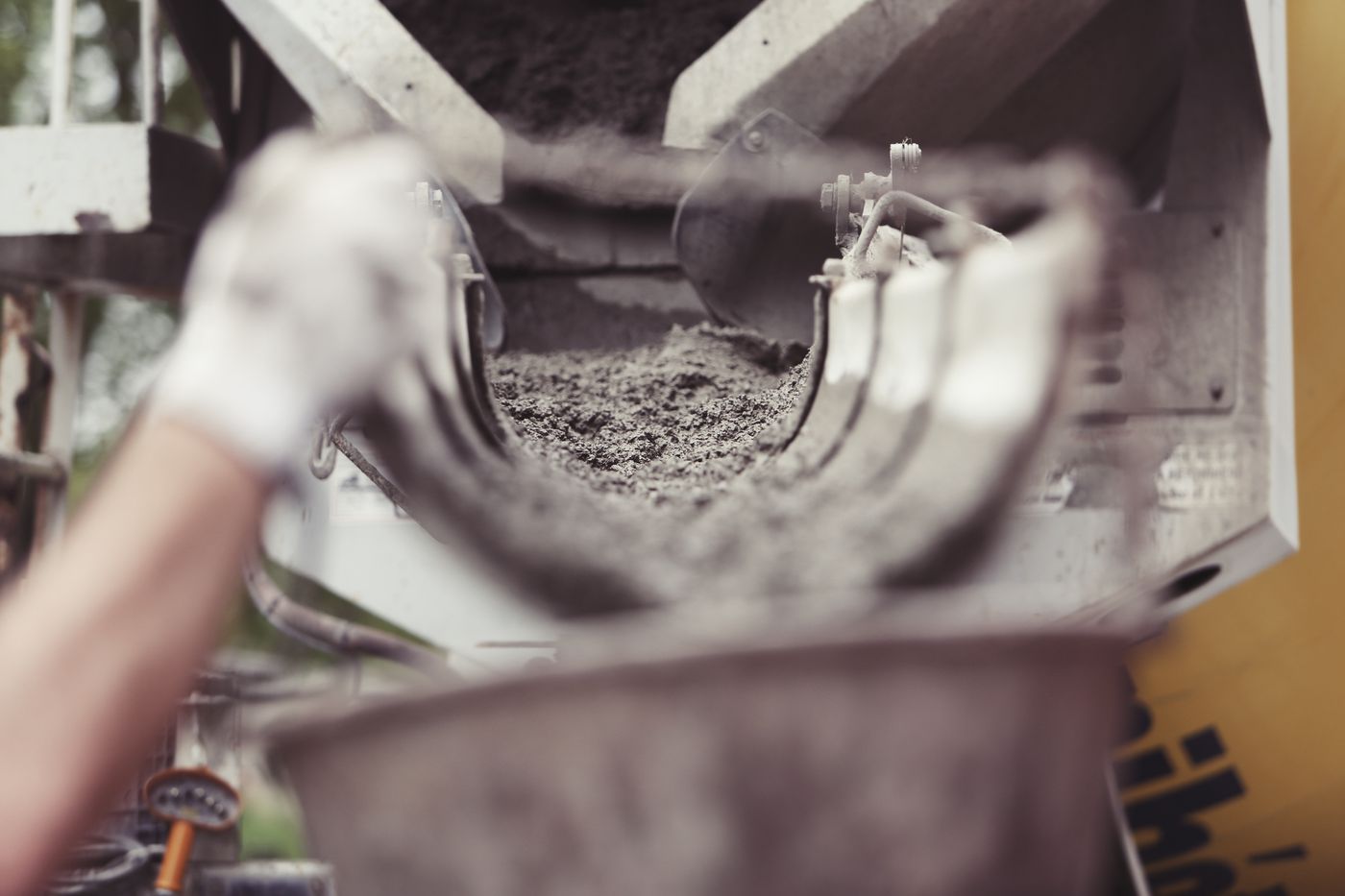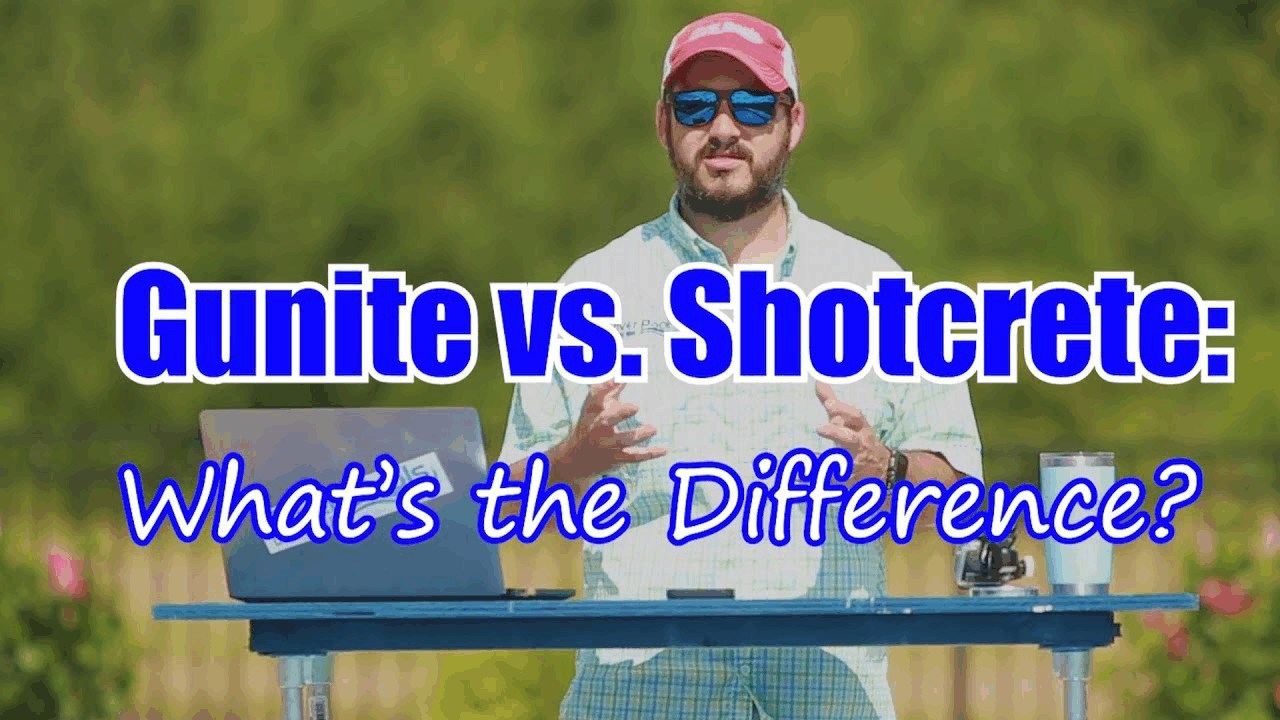
Concrete pools are often called “gunite” pools... but you may have heard of "shotcrete" pools, too. Researching your options when you want to buy an inground pool can feel overwhelming if you're unfamiliar with all the terms, technologies, methods, and processes professional pool builders toss around on a daily basis. But it's not as complicated as it can seem from the outside.
This guide will help you understand the difference between gunite and shotcrete -- particularly when you want to use this material to build a sleek inground pool in your backyard. When you can speak a pool builder's language, you'll be on firm footing to negotiate your pool project's dimensions, costs, timelines, and options.
Let's get started...
Concrete fundamentals
Concrete is a mix of water, cement, sand, and a coarse aggregate, which is a material made up of small particles, usually small crushed stones or gravel.
The difference between sand and aggregate mainly comes down to the size of the particles and (sometimes) what they're made of. The sand you'll find at the beach or in the desert is usually made of quartz or limestone, but sand particles are always smaller than gravel, even if sand and gravel are made up of the same basic chemicals.
Dry concrete is considered an "initial mixture" of cement, sand, and aggregate. The process of mixing water into an initial mixture of concrete gives the end product its name.
Shotcrete can be either wet-mix or dry-mix concrete, as long as it’s shot out of a hose, Shot concrete. Shot-crete. Get it? It ain't fancy, but it fits.
Gunite is also shot out of a hose, but it's a dry mix until it's applied.
This might be a little confusing, so let's dive deeper into the ways pool builders typically use these two terms. There is a clear difference, as you'll see...
The difference between gunite and shotcrete in concrete pools
Concrete pools can be constructed with the shotcrete or gunite process. The difference is when the concrete mixes with the water. Shotcrete always refers to wet concrete that's already fully mixed before it's shot out of a hose. Gunite is a dry concrete mix that only mixes with water at the end of the nozzle as it's being sprayed onto its final surface.
Shotcrete is the type of concrete that'll show up at your home pre-mixed with water in the barrel of a cement truck. However, most concrete pools are built using the gunite process, because it tends to be easier to spray onto surfaces to the desired thickness.

Concrete pool construction
Constructing a concrete pool follows very similar processes, whether using the gunite or shotcrete method:
- Excavate the hole in which your pool will be installed
- Install pool plumbing.
- Install a reinforced "cage" of steel rebar on walls and floor.
- Spray concrete (shotcrete or gunite) to encase the rebar.
- Shape and finish concrete pool shell.
- Cure concrete.
- Install tile and coping
- Install patio.
- Apply finish (plaster, aggregate, or tile).
- Start the pool.
Using gunite to build a concrete pool
When using gunite (dry mix), pool builders will load pre-mixed dry concrete into a "hopper," which feeds the material into a hose. Compressed air pushes the dry mix material through the hose and out of a gunite nozzle, which mixes the concrete with water. The technician or "nozzleman" can control the amount of water mixed into the dry material to better manage the consistency of the concrete as he applies it to the walls and floor of your pool.
Yes, "nozzleman" is a professional job title. There are even nozzleman certifications!
Using shotcrete to build a concrete pool
When using shotcrete (wet mix), pool builders will load fully mixed wet concrete into a compatible hopper, using compressed air to shoot the wet mix through a nozzle.
Both gunite and shotcrete processes use high-pressure nozzles to ensure the concrete compacts as densely as possible, leaving no pockets or bubbles of air in the applied concrete structure.
Pros and cons of gunite pools
Gunite advantages
Poured concrete, which you'll most commonly see on sidewalks, won't bind together with different applications of concrete if one is poured after the other solidifies. For example, if you stopped pouring concrete and left your sidewalk with a rough edge, you'll create a "cold joint" if you came back later and poured more concrete after the rough edge dries.
These two "pours" will look different, and you may very well wind up with cracks in the area where you attempt to blend the two pours together. If you've ever seen a sidewalk with cracks or flaws where two different colors of concrete meet, it's almost certainly because the builders responsible took a break when they shouldn't have.
The gunite process allows a skilled technician to apply concrete multiple times without risking a cold joint or point of weakness. The high velocity spray of material from the gunite nozzle ensures each round, batch, or session of sprayed concrete will still bond together.
Gunite generally allows builders to take more time to complete the project properly since they can stop and start as needed. Gunite tends to be less expensive than shotcrete, and it can result in fewer errors in the construction process. You may be impatient to get into your new pool, but when you're building something you want to use for decades, it's worth waiting a bit longer for a flawlessly-built pool.
Gunite disadvantages
The gunite process requires a highly skilled nozzleman. Any errors in the ratio of dry-mix concrete (including the ratio of its component materials) and water can wreck final the quality of the concrete walls and floors of your new pool.
Improperly loaded dry mixtures can also sometimes clog the hose pipe.
Gunite also creates a lot of excess material, called rebound. It's a big mess, and you can’t reuse rebound material, which can be a drawback if you're trying to build your pool in the most environmentally conscious possible way.
Pros and cons of shotcrete pools
Shotcrete advantages
Shotcrete nozzlemen need to be skilled, but they don’t require as much technical training as someone working with gunite, because they don't need to worry about the ratios of dry mix to water when spraying premixed concrete.
Shotcrete forms a strong and consistent coating, and a shotcrete construction process typically takes less time than a comparable gunite process.
Shotcrete disadvantages
Since shotcrete is premixed, it must be applied quickly in a single day or in an uninterrupted construction session. The nozzleman can’t stop and start because any premixed concrete, whether sprayed or poured, won’t bond to a separate application of concrete that's already dried.
Cracks can form if the premixed concrete uses too much water. Some builders might add water to the mixture in the cement truck to keep it from hardening while they work. This can compromise the strength of the concrete.
Overly watery concrete is technically a drawback when you're using concrete in any sort of construction project. However, with shotcrete, you're dependent on the skills of whoever's controlling the cement mixer, as well as on the skills of your nozzleman. More people means more points of potential failure, whether you're building a pool or ordering a pizza.
Because of its narrower time window, shotcrete tends to be more expensive than gunite.
Should you get a gunite pool or a shotcrete pool?
The use of gunite or shotcrete is typically your pool builder’s choice. Gunite and shotcrete processes can both result in a high-quality pool if properly utilized.
Some builders have dialed in their mix and can spray it quickly, so they'll be more comfortable with shotcrete. Other builders might employ master nozzlemen, but may not have the resources to finish applying concrete in a single session. These builders will probably use the gunite process. These are ideal outcomes, of course -- some builders may use processes they're not fully trained in, which is why it's so important to properly vet any potential pool builder before you sign a contract for a pool project.
Concrete pools, especially larger pools built with the shotcrete process, typically range from $95,000 to $200,000 or more to install. Fiberglass pools on the other hand, typically range from $85,000 and $200,000 or more to install. It's also worth noting that concrete pools are typically more expensive to maintain -- check out our detailed guide to pool maintenance costs to see what your true long-term investment might be with different types of inground pools.
If you're not yet sure if concrete -- whether it's a gunite pool or a shotcrete pool -- is the best type of pool for your backyard, you might want to try our new Pool Type Selector tool. It'll guide you through common options and help you figure out if you should get a concrete, vinyl liner, or fiberglass pool installed in your backyard. Just click the banner below to try it out!
If you're shopping around for a fiberglass pool, feel free to take a look at our catalog of models, visit our extensive video library, try out our pool cost calculator, or request custom pricing using the button below.
Up Next:
How Much Does Resurfacing a Concrete Pool Cost?
Are Salt Water Systems Bad for Concrete Pools?
What Is an In-Floor Pool Cleaning System? How It Works, Cost, Pros, and Cons
Editor's note: This article was originally written by Holly Jender and was updated on March 11, 2025 with current information. River Pools is a brand of inground fiberglass pools produced in a manufacturing facility in Fortville, IN. While our expertise is in manufacturing fiberglass pools, we have access to a network of installers with expertise relating to project design, installation, and pool service. We often tap into this knowledge base and share information freely with homeowners, just like you, considering installing a swimming pool in your backyard.


